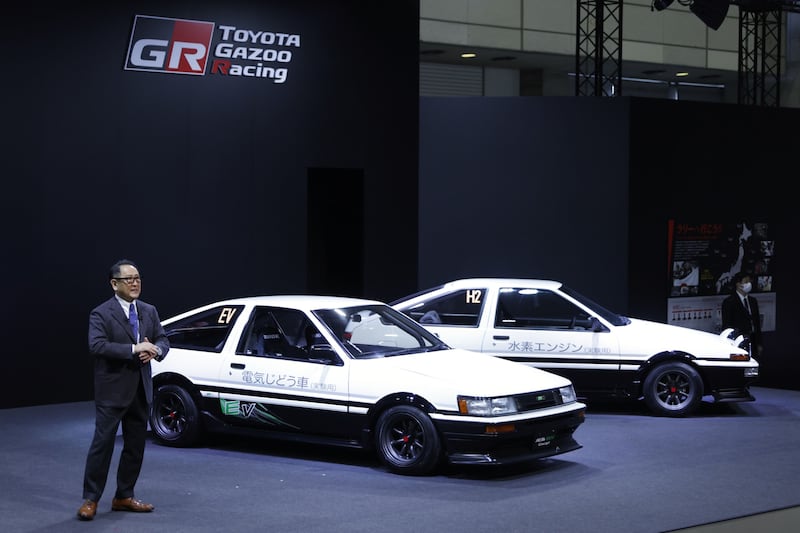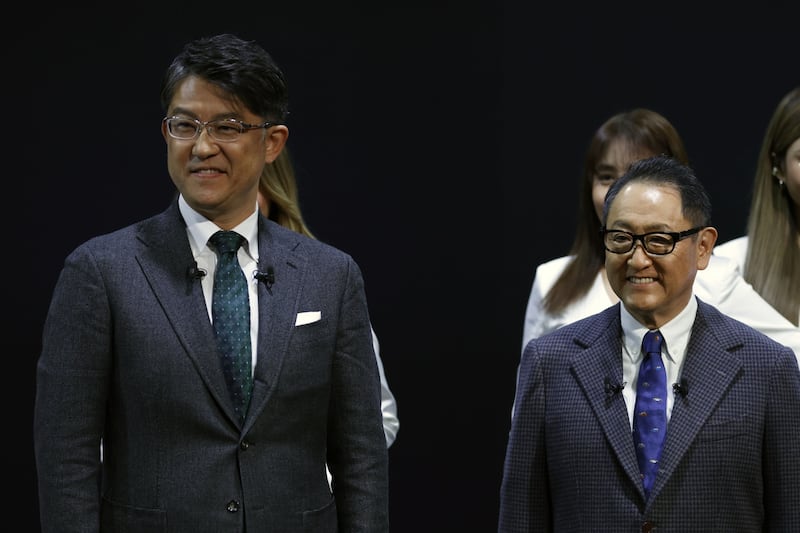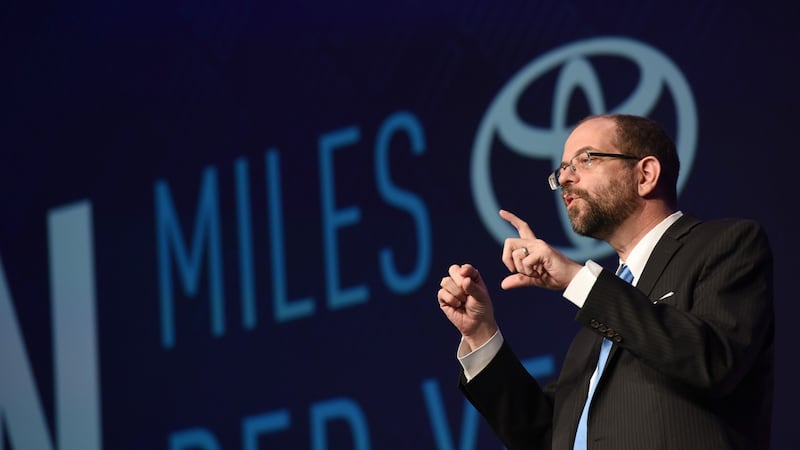Leaning on your heritage is always a good idea. Rolling out some classic models generally gets people putting on their warm and fuzzy nostalgia glasses, and can act as a useful distraction from other woes.
So it was that at the recent Tokyo motor show, Toyota pulled out a pair of concept cars which, at a glance, appear to have come from the mid-1980s. The Japanese giant had a pair of Corolla AE86 coupes on its stand, a model which has gone down in petrol-head legend as a rally car, a drift racer, and an affordable high-performance vehicle. Go and search for ‘Initial D’ on your online video channel of choice to find out more…
These AE86s were not conventional ones, though. One had been entirely shorn of its classic twin-cam petrol engine, having it replaced by a battery-electric powertrain but equally having kept its original manual gearbox for a little more driver interaction.
The second AE86 concept kept its ‘4AGE’ four-cylinder engine, but had had it converted to run on hydrogen gas, supplied by tanks borrowed from Toyota’s hydrogen fuel cell car, the Mirai.
Have your say: Has Holyhead Port disruption impacted your Christmas present parcels?
‘She’s a broken woman’: Homeowner paid €9,000 to liquidated Dublin windows firm
Stephen Collins: Despite the rhetoric from Mary Lou McDonald, Sinn Féin was the big election loser
Radio Review: At Newstalk, Ciara Kelly gets righteously annoyed

The two cars had been created under the banner of “Toyota: Leaving no car lovers behind” and are designed to “Expecting that it will take time before all new vehicles are carbon neutral, simultaneously promoting the carbon neutralisation of not only new vehicles but also of vehicles currently in customer use is essential for the future.”
Doubtless, these concept cars have brought a large smile to the face of Akio Toyoda, chief executive of Toyota, scion of the Toyoda business empire, and grandson of the founder of the Toyota Motor Corporation. Toyoda is renowned in the car industry as a senior executive who loves his cars and considers himself as much racing driver as boardroom manager.
Perhaps more so now — Toyoda, in an announcement that’s at least a surprise if not an outright shock, has said that he’s stepping down from his twin positions of Toyota’s chief executive and president, and handing the reins of power over to Koji Sato, currently head of Toyota’s branding operations and also the man in charge of the luxury Lexus marque.

It’s tempting to see Toyoda’s departure as paying the price for Toyota’s current dramatic underperformance in the electric car market. Indeed, this correspondent said just that, only to be rebuked by Jean-Yves Jault. Jualt, a former senior public relations officer for Toyota, said: “Anyone who reads Toyoda-san stepping down as a move reflecting performance related or imposed from outside is getting it wrong in my opinion. This is a move he’d been mulling for a while probably, wanting to take some time. Sato-san has been groomed through Lexus, and motorsports. There’s no ‘backstory.’”
Nonetheless, Toyoda has been vocal in his defence of Toyota’s bearish position on electric cars. 18 months ago, Toyoda posed with a phalanx of future electric Toyota and Lexus models, from a humble four-door saloon (and a four-door Tesla Model 3 called bz3 will be Toyota’s next all-electric model on sale) to a high-performance electric Lexus supercar, designed to succeed the classic V10-engined LF-A.
Even so, Toyota has long been seen as a laggard in electric car terms, and the company has stated both that it sees its existing hybrid and plug-in hybrid technology as a potential better fit for most customers right now, and that it is waiting for the maturation of ‘solid-state’ battery technology before it goes all-in on EVs.
None of which is good enough for its critics. Toyota has been roundly lambasted by the likes of European environmental think-tank Transport & Environment, which has accused Toyota of “using its power to stop ambitious climate laws.” T&E’s claim is that Toyota’s initial leadership in hybrid power made it complacent, and now it’s trying to muddy the environmental motoring waters. “Toyota had the chance to own the green car market, but it fell asleep behind the wheel, and is now lobbying to prevent electric vehicle mandates and clean air laws” claimed T&E.
Making a hydrogen version of the classic AE86 to sit alongside a battery version is perhaps not surprising — Toyota has long predicted a hydrogen-powered future, and it’s currently building a huge hydrogen-powered city, called Woven City (a reference to the company’s roots as a maker of weaving looms) near Tokyo. Two new hydrogen prototypes have been announced, based on the Hilux pickup and the new Corolla Cross SUV, and Toyota has also put forward hydrogen as a potential replacement for petrol and diesel, potentially capable of de-carbonising the world’s existing combustion engines.
Can it ever come to fruition, though? While broader hydrogen research continues, Toyota looks increasingly lonely when it comes to hydrogen cars, and the problem is that versus electric cars, we’d need huge investment in a network of hydrogen fuelling stations, plus the supply of those stations, but every house and building is connected to the electricity network.
While it continues to soldier almost alone with hydrogen power (others, such as BMW and Hyundai occasionally dabble but don’t quite have Toyota’s commitment) the Japanese giant is facing serious accusations of actively trying to hold up the development of fully-electric cars. Indeed, one survey by InfluenceMap, put Toyota’s name up there with the likes of ExxonMobil and Chevron as a global climate villain, pointing to the car maker’s efforts to water down electric car grants in Japan, opposing stricter fuel economy and air quality laws in the US, and generally failing to bring fully-electric models to the market. A recent article in Slate magazine in the US took Toyota seriously to task for its apparent inability or unwillingness to commit to an all-electric future, as so many of its rivals are already doing.
Indeed, what was supposed to be Toyota’s great hope for EVs, the bz4X, was supposed to be on sale in Ireland since June of 2022, but was delayed by a global recall for faulty wheel fitment (which could actually cause a wheel to simply fall off — something of a metaphor for Toyota’s EV efforts so far?) and which still does not have a properly listed price in Ireland.
Why does Toyota still have doubts when it comes to electric vehicles? Dr Gill Pratt holds the rather grand title of Toyota’s Chief Scientist and Executive Fellow for Research, and he recently gave a presentation to the World Economic Forum in Davos.

“The gap between the demand for lithium [a vital component of electric car batteries] and predicted supply all the way up to 2040 is large” said Dr. Pratt. “There’s this incredible gap. The International Energy Agency actually puts the gap at as much as 50 per cent. This keeps me up at night because my question to myself is how are we going to get there? There won’t be enough lithium, because mines take 10-15 years, I’ve even heard 16 years, to get established. Battery factories take only two years to get going, so there’s going to be a huge supply crunch. Our thesis, and Toyota is not alone in this, but I think we’re sort of the thought leader in this, is that we should electrify vehicles as much as possible but we don’t have to electrify them in only one way.
“The one way that you’re most familiar with is the pure battery-electric vehicle, the one that plugs in and then drives purely on the batteries. But those use a lot of lithium. The other is a plug-in hybrid electric vehicle, or a range-extender, that has a petrol engine on board to charge the batteries. And then finally there are hybrids which is older technology, which uses gasoline but at a much more highly efficient rate. All of these use lithium, but in different amounts.”
Pratt’s thesis is that by concentrating lithium usage in a small number of fully electric vehicles doesn’t bring the average emissions of a national fleet of cars down by enough. By spreading the available lithium out over as many vehicles as possible — hybrids using small batteries — Gill reckons that emissions can be cut by more, more quickly. “So even if the individual performance is not as good, the net effect, given that lithium is the critical resource, is actually far better. To be clear, we’re not suggesting that everyone switch entirely to hybrid cars. Toyota is going to make 3.5-million battery-electric cars per year by 2030. But, we think that in certain parts of the world, where the charging infrastructure is not as ‘green’, where there are people that don’t have easy access to charging, that some of these other options may in fact be better. So let’s use the lithium where it does the most good.”
So, is Toyota a climate criminal? A company so bent on protecting its long-cherished position as king of the hybrids that it’s losing sight of the bigger picture? Or is it simply being pragmatic, and pragmatic in a way that doesn’t chime with the vision of the future of motoring being espoused by so many? Arguably, only time will tell, but that’s time that the world may not have when it comes to ameliorating the worst effects of climate change. It’s also time that Toyota may not have — back the wrong horse now, and even this titan of Japanese industry could be facing a bleak future.




